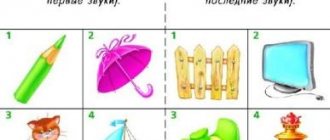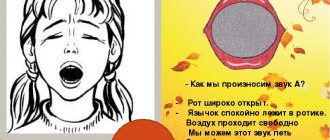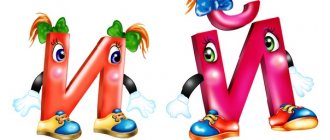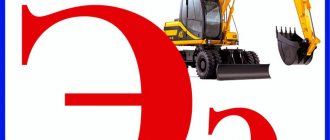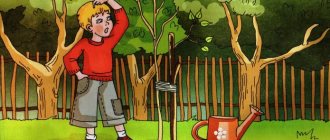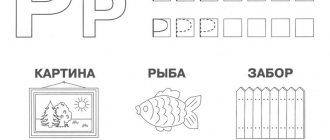Goals and objectives
Goals:
- Preschool children learning the vowel “Y”.
- The child’s discrimination of the sound [ы] and its clear pronunciation.
- Teaching preschoolers the formation of plural forms of nouns.
Tasks:
- Familiarization of a preschooler with the sound [ы] and its graphic representation.
- Acquisition of initial skills in phonetic analysis.
- Development of word-formation skills (formation of adjectives from nouns).
- Development of fine motor skills in the process of depicting “Y”.
- Development of phonemic awareness and skills of expressiveness and speech intelligibility.
Outline of the GCD on the topic “Sound and letter “Y” in the senior speech therapy group
Transcript
1 municipal budgetary preschool educational institution “Kindergarten of a combined type 365” of the Samara city district (MBDOU “Kindergarten 365” of the city of Samara) address: , Samara region, Samara, st. Flotskaya, 15 a tel/fax: , e-mail.: Outline of GCD on the topic “Sound and letter “Y” in the senior speech therapy group Conducted by: Vladimirova Ekaterina Mikhailovna, teacher-speech therapist MBDOU “Kindergarten 365” O. Samara Samara, 2018
2 Topic “Sound “Y”” Integration of educational areas: social and communicative development; cognitive development; speech development; physical development. Goal: familiarization with the sound “Y” Tasks: word; develop phonemic hearing, the ability to determine the location of a sound and consolidate the ability to distinguish between hard and soft, deaf and voiced consonant sounds; improve hand-eye coordination and fine motor skills; be able to compose sentences of five or more words using subject pictures. develop constructive abilities. Methods and techniques: practical, visual, verbal. Materials and equipment: mirrors according to the number of children, bells, chenille (chenille) sticks for constructing letters, red, blue and green squares for indicating sounds, cardboard strips “houses” for determining the place of a sound in a word, object pictures, trays, ball , the letter "Y" with the smell of smoke. Forms of organizing interaction: Children's Forms and methods of organizing joint activities Motor games for motor coordination Play Game situations Communicative Speech situations, word games, situational conversations, questions Construction Constructive games
3 Logic of educational activity Stage of the lesson Tasks Activities of the speech therapist Activities of the students Motivational-organizational Game situation Activity Develop the ability to isolate a vowel sound from a word with one syllable. Strengthen the ability to identify articulatory features of vowel sounds. The speech therapist asks a riddle: “Something is coming out of the pipe. We want to catch him! But it goes to heaven, There is only a stripe from it! It is always elusive, Because it is...(smoke).” Then he asks the children if they can see the smoke? And hear smoke? The speech therapist asks the children to pronounce the words “dy-y-ym”, “sy-y-yr”, “we-y-ysh” and isolate the vowel sound from the word. The speech therapist asks the children to take the mirrors and pronounce the sound “Y”. Draws children's attention to the position of the organs of articulation when pronouncing the sound “Y”. Then he asks the children to turn to face each other (work in pairs) and look at the position of the neighbor’s organs of articulation. Next, the speech therapist asks to characterize the sound “Y”. Repetition: does the speech therapist clarify what other vowels the children know? Children sit at tables, solve a riddle, and answer the speech therapist’s questions. Children pronounce words, select vowel sounds from words. Children look in the mirrors, observe the position of the organs of articulation in themselves and their neighbor, and give a description of the sound “Y”. Children name the vowels A, O, U, I, E, and answer questions. Expected results Children identify vowel sounds from words. Children identify articulatory features of vowel sounds and recall previously learned letters.
4 Consolidating the ability to identify by ear deaf and voiced, hard and soft consonants. Strengthening the ability to distinguish vowels and consonants by ear. Develop the ability to transform words from singular to plural (Letters are written on the board), what color are they indicated by? The speech therapist invites the children to take Children take bells, bells and ring them, identify the sound and ring if they hear a ringing one if necessary. consonant. Then the speech therapist Children determine by ear pronounces a series of consonants, hard and soft sounds, sounds (for example: p-z-v-g-f-b-raise the corresponding squares.). Next, children are asked to take sets of squares and “signal” - raise the corresponding square upon hearing a hard or soft sound (blue or green). The physical education speech therapist invites the children to get up from the tables and play. The condition is reported: if you hear a vowel sound, the posture is as open as possible (“Zhikharka”), if the consonant is closed, sit down and curl into a ball. The speech therapist pronounces sounds (eg: o, v, u, k, p, i), while deliberately making incorrect movements. The speech therapist throws a ball to the child, names the word in the singular and asks to name the word in the plural. Speech game “1 - many.” Children identify the sound and carry out the speech therapist’s task: squat or open up, not paying attention to the speech therapist’s incorrect movements. The child catches the ball, names the word in the plural (For example: cat cats, cheese cheeses, mouse - mice) Children distinguish between deaf and voiced, hard and soft consonant sounds. Children distinguish between vowels and consonants. Children convert words from singular to plural
5 Strengthen the ability to determine the place of sound in a word Improve spatial orientation and gross motor skills Introduce the letter “Y”. changing only the ending of the word. Speech game “Place the residents in their homes” The speech therapist suggests taking the Children take sets of “house” cards and sets of squares, choose a color, colored squares. You need to determine by ear the place to hear the sound “Y” in a word and the sound in a word and indicate its place by indicating it on the diagram. with a “tenant” square (red) the corresponding “apartment” in the “house”. (for example: owl, dive, notes, whip, canvases, skis). Draw the attention of children that in the Russian language there are no words where “Y” is at the beginning of the word. Physical education session The speech therapist suggests standing up and doing exercises to the verse: (The rats quickly dug the hole so that the cat wouldn’t know about it, so that the mice would steal cheese and candy from the buffet). Game situation The speech therapist shows the children the printed lowercase letter “Y”. He asks what elements it consists of, how these elements are located, what the letter “Y” looks like. Then he invites you to smell the letter “Y” and share your feelings. The teacher seeks full Children leave the tables; after listening to the poem, they perform movements to the rhyme, repeating the verse and exercises after the speech therapist. Children examine the letter, highlight the elements of which it consists. Then they name their associations, what the letter “Y” looks like. They smell the letter, try to guess the smell (smoke). Answer in complete sentences. Children determine the place of sound in a word. Children perform movements to rhyme, repeating after the speech therapist. Children become familiar with the letter "Y".
6 Fix the visual image of the letter “Y”. Strengthen the skill of working in pairs. children's answers. Constructive game “Fold the letter” The speech therapist invites the children Children construct a letter Construct the letter “Y” from “Y”, agreeing and chenille sticks (work in distributing tasks. pair) Children consolidate the visual image of the letter “Y”; agree. Final Strengthen the skill of composing common sentences. The speech therapist invites the children to take out and look at the cards with pictures that are hidden under each tray, and name them. Then make a sentence of 5 or more words with this word. (for example: soap, mice, reeds, smile, scissors) Conversation The speech therapist asks the children what sound and what letter they were introduced to in class, asks them to characterize this sound. Then he asks the children to say what they liked during the lesson, what caused difficulties. At the end of the lesson, the number of stars is counted, 3 - a sticker. Children name words with the sound “Y”, make sentences of 5 or more words. Children answer questions, describe the sound, say what they liked and what caused difficulties. Children consolidate the skill of composing common sentences.
Tales about the letter Y
During the lesson, preschoolers can read a fairy tale about the vowel Y, which reveals its importance. Also suitable is the fairy tale by G. Yudin with the abundant use of “Y” “The Rat Tallda and Puff-Puff.”
Her heroes, the mouse Mouse and the chicken Little One, ate melon together one evening. But then another heroine appears - the rat Dilda. She threw herself under the Mouse's bed in wild fear. It turned out that on her bed someone, hiding under the blanket, was making strange sounds: “Puff-puff.” The big rat Dilda called out to her little friends for help. Bravely, the mouse and chicken went to explore. The big man was shaking under the bed.
They returned soon. At the same time, Mouse wiped his mustache. This was the puffing pie dough that Dylda's mother had put in a warm place. Mouse and Chicken, without thinking twice, ate it.
Sound production
It is best to introduce the vowel [Y] to the child, as well as other sounds, in the game. The game “One - Many” is effective. It consists in the formation of plural forms of nouns. For example: cat - cats, tooth - teeth, foxes, vase - vases.
It is better to choose nouns of the first and second declension for the game in advance, since not all of them have the ending -y in their plural form. During the game [Y] is pronounced clearly.
For a consolidating exercise, it is good to sing the vowel [І] in different modes: in low and high keys, long and short. At the same time, you can depict the howling of a mighty wind bending trees, and the quiet blowing of a light breeze. This is how the articulation of sound is practiced.
It is worth paying attention to the peculiarity of “Y” in the Russian language: it is never at the beginning of a word, it can only be located in the middle or at the end of it (cheese, smoke, mustache).
The mechanism of transition from pronunciation I to Y.
It is advisable to reinforce the skills of clear pronunciation of the sound [І] with its articulatory characteristics: openness of the lips and teeth during pronunciation; tongue position (passive); no obstruction to the flow of air from the mouth.
Children's attention should be drawn to the fact that “Y” is involved not only in the formation of plural forms, but also in the formation of new words. Thus, clocks that can be located on the hand, on the wall or on the table are called wrist, wall, or table clocks.
Introducing the letter Y
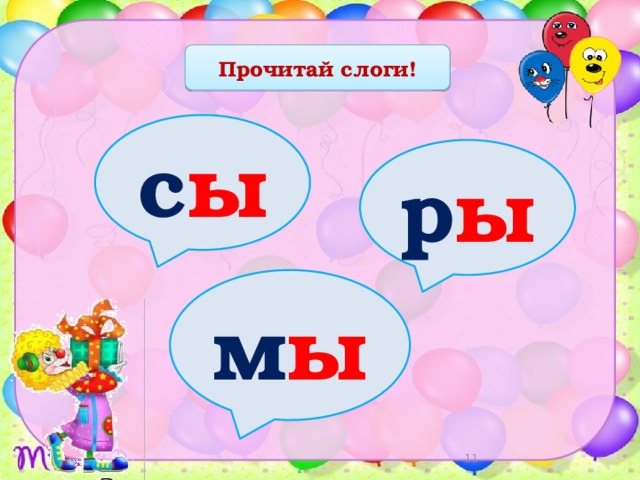
Before starting to introduce children to the vowel “Y”, it is necessary to remember the already familiar sounds and the letters A, O, U, I corresponding to them. It is necessary to clarify that these sounds are vowels, that is, they are pronounced freely: the sound comes out through the oral cavity unhindered.
Next, we inform the children that there is also a vowel sound [Y]. For clarity, you can sing combinations of the vowels a, o, u with the vowel Y - ay - oy - y. After the children have listened to the vowel [Y], it is logical to show them its graphic designation - the letter “Y”.
Assignment for preschoolers: printed letter Y
After oral work, the child is asked to carefully examine the graphic image of “Y”. Then write it in the air, and then in a notebook. “Y” is written in cells; both a ballpoint pen and a pencil are suitable for writing.
If a preschooler is faced with the task of writing a letter throughout the entire line, then the adult himself must write “Y” at the beginning of the line as a sample.
If children have difficulties, an adult can help them with two lines or reference points for drawing lines. As a last resort, you can write the entire letter to the child so that he simply circles it with a colored pencil or pen.
There is no need to require calligraphic writing from a preschooler.
Program objectives: 1. Introduce children to the letter “Y”. 2. Continue to teach children to carry out sound-letter analysis of words and qualitatively characterize sounds. 3. Strengthen children’s ability to divide words into syllables.
4.Develop phonemic awareness. 5.Cultivate interest in learning activities. Demonstration material: subject pictures: orange, melon, apple, magnetic board, small letter “Y”, chips for sound analysis. Handout material: chips for sound analysis, letter boxes, didactic game “Hide and Seek”, pointers.
Progress of the lesson
1.Q: Children, what grows in the garden? D: Children's answers Q: What did you call now? D: Words B: Now I will pronounce pure phrases in which there is no last word. Tell me this word. Bus-bus-bus - we sowed... (watermelon). As-as-as - bought... (pineapple). In-in-in - we ate a delicious...(orange). 2.Q: Guess what grows in my garden. His brother is a tangerine, what kind of fruit is he.... D: Orange (The teacher displays a picture of an orange). Q: It's oval, like a baseball. If it's ripe, everyone is happy. D: Melon B: Round, ruddy I grow on a branch, Adults and little children love me. D: Apple 3.Q: Children, how do you find out how many syllables are in the word apple? D: The number of times you clap your hands, the number of syllables. Q: Clap the word and say how many syllables it has. D: The word apple has 3 syllables. Q: How many syllables are in the word melon? D: The word melon has 2 syllables. Q: How many syllables are in the word orange? D: The word orange has 3 syllables. Q: Name the shortest word. D: The shortest word is melon. Q: Explain why you think so? D: This word has 2 syllables, the words orange and apple have 3 syllables each. 4.Q: Name the second sound in the word melon. D: In the word melon, the second sound is “y”. Q: What do you know about him? D: This sound is sung, it is a vowel. Q: What other vowel sounds do you know? D: O, U, I, E, A Q: What other sounds are there? D: Consonants are hard and soft. Q: The one who names the hard consonant sound will sit in his place. D: call the sounds, sit down. 5.Did. game “Hide and Seek” Q: The sound “y” likes to play hide and seek. Prepare a card and a chip. I will name the words, if the sound “y” is at the beginning of the word, then put the chip in the first cell. If the sound “y” is in the middle of the word, then place the chip in the second cell. And if you hear the sound “y” at the end of a word, where do you put the chip? D: In the third box. The teacher names the words. Children place the chip in the correct cell, in accordance with the position of the sound. (smoke, soap, birch, son, lid, pine, etc.) Q: What conclusion can be drawn about the sound “s”? D: This sound can be in the middle of a word, at the end. There is no word starting with the sound “y”. 6.Q: What letter do you think we will get to know today? D: With the letter Y. Q: If the sound “y” is heard in a word, then we will write the letter Y. From below to the line, my friend, quickly draw a circle, then place a stick, and make the letter “y” like this. Q: Find the house of the letter Y at the box office. Take it out and show it to each other. D: I only have a small letter Y. Q: Children, why do you think there is no capital letter Y at the cash register? D: Because there is no word starting with Y. B: Well done. 7.Phys. minute 8.Prepare chips for sound analysis. Put the word melon in its place. Sasha conduct a sound analysis at the board. Then we will compare. (Children parse the word, indicate sounds with chips) Q: Now we will check your work. Sasha will name the sound and give it a description. Don't shout from your seat, express your opinion using the + or - signs. D: In the word melon, the first sound is “d”. This is a hard consonant sound, denoted by a blue chip. Q: Children, show your opinion. (Children show + if they agree, if they disagree -). Q: How many sounds are there in the word melon? D: Four Q: How many vowel sounds? D: Two B: Let’s denote vowel sounds with letters. What letter do you think we use to denote the sound “s”? D: Letter Y. Q: What letter do you think we use to represent the sound “a”? D: Small letter I. Q: Why do you think so? D: After a soft consonant we hear “a”, and we write the letter Y. (Children lay out only vowel letters and read the resulting word.) Q: Children, what interesting things did you learn in class? D: answers Q: Clean up your workspaces. Who will tell you about the new letter at home today? Thanks for the work. Well done.

